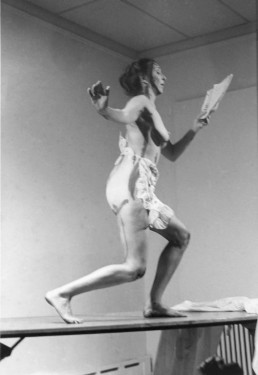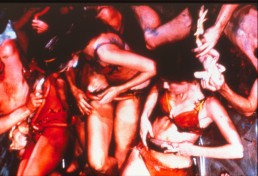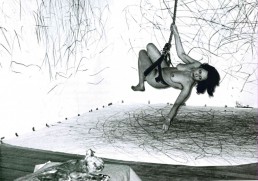Articles and Features
Lost (and Found) Artist Series: Carolee Schneemann
By Artland Editors
Artland’s Lost (and Found) Artist Series focuses on artists who were originally omitted from the mainstream art canon or largely invisible for most of their career. “Lost (and Found)” began with the pioneering abstract artist Hilma af Klint and Mary Corse, and the third artist in the series is Carolee Schneemann, the pioneering performance artist who influenced figures including Marina Abramovic, Matthew Barney and Pipilotti Rist, as well as newer generations of artists who take the body, sexuality and gender as their point of departure.

We think of Marcel Duchamp as an artist that shocked the world with his Fountain (1917), but when Carolee Schneemann performed Meat Joy at the Festival of Free Expression in Paris in 1964, it was Duchamp himself who was shocked, declaring her performance the messiest work of art that France had ever witnessed.
Schneemann’s Meat Joy involved semi-nude men and women, including the artist herself, rolling around on the floor in bikini briefs, slathering each other with blood-red paint while clutching dead fish and raw chicken. Although the scene was almost operatic in scale, the music chosen was a pop-score composed by her then husband, the avant-garde composer James Tenney.
Meat Joy is clearly influenced by Schneemann’s work with Judson Dance Theater (of which Carolee Schneemann was one of the original members), a 1960s artistic collective that found meaning and movement in everyday actions, whether it was walking, running or lovemaking. Carefully choreographed by Schneemann, Meat Joy captures the spontaneity and joy of physical contact, as well as the general air of sexual liberation at that time.

More than a painter
When Carolee Schneemann passed away on the 6th of March, aged 79, she left a legacy of art production that always concerned itself with the friction created by the body, a concern which she remained devoted to across sixty years of innovative and canonical provocations. While she describes herself as a painter — “I’m a painter. I’m still a painter and I will die a painter. Everything that I have developed has to do with extending visual principles off the canvas.”— Carolee Schneemann worked across multiple boundaries of media, encompassing painting, sculpture, collage, drawing, bookmaking, photography, performance, installation, film and writing, and remains most remembered for her extraordinarily moving and challenging performance pieces.
When Carolee Schneemann was born on Oct. 12, 1939, into a middle-class family in a then rural neighbourhood of Philadelphia, it did not seem likely that she would become a revolutionary artist. Yet the seeds for how she understood and would eventually express the human body were sown during her childhood. As she tells Interview Magazine, she sees a connection between the farm work she did and creating art: “My sense of space and material has a lot to do with having been a chicken-killer and working with cows.” Her father, a country doctor, also contributed to her direct and unfiltered way of looking at the body. Schneemann often accompanied him on visits and assisted with minor injuries that came through the door. As she recounts in an interview with Carl Hayward: “There was always physicality around us, leaking, spilling out of boundaries, wounded farmers with bleeding limbs, hemorrhages, infections. No fantasy of the sanitized body in this household.”
Schneemann’s interest in art and the natural world led her to enroll at Bard College in 1955, despite her family’s objections, to study painting on a full scholarship. However, there she encountered an all-male studio faculty more interested in having her pose for them than educating her as a scholar. In response, she produced nude-self-portraits, which led to her expulsion. Following that, Schneemann enrolled in the art program at Columbia University, where she continued to paint in a gestural style that borrowed something from Cezanne and a lot from Abstract Expressionists like Arshile Gorky and Willem de Kooning. In her paintings from the 1950s, landscapes and bodies seem charged with an organic energy, which was a way of perceiving the world that would last her entire career.
Interior Scroll and other things
One of Carolee Schneemann’s most famous works is the groundbreaking Interior Scroll (1975). During Women Here and Now, an exhibition of paintings accompanied by a series of performances in East Hampton, New York, in August 1975, Schneemann undressed herself onstage and wrapped herself in a sheet in front of an audience comprising of mainly women artists. In the posture adopted often by life models and muses, Schneemann began to read from a book of her collected writings titled Cezanne, She Was a Great Painter (1974). These writings included a litany of misogynistic responses a female artist could expect to encounter in her career, such as “to be mistreated whether your success / increases or decreases” and “they will patronize you humor you / try to sleep with you want you to transform them / with your energy.”
After setting the stage with these statements, Schneemann put the book down and then memorably extracted a narrow strip of typewritten paper from her vagina, which included responses to personal criticisms of her work, reading aloud the text on the scroll as it emerged.
While Interior Scroll has become a canonical piece in the history of performance art, Schneemann saw the body as being invested in things beyond sex, erotics and art criticism. In a recent article from The Guardian, Amelia Jones shares how Schneemann had chastised her for “focusing repeatedly on this key piece [Interior Scroll] rather than attending to her paintings, her films and her many other more material art works.” Indeed, in her work, Carolee Schneemann criticised not only the gender politics of the art world, but the politics of aesthetic structure itself.
Against Abstract Expressionism
In the 1960s, Schneemann had entered an art world fascinated by abstract expressionism and its male painters. To express her frustration with the state of affairs, Schneemann performed Up to and Including Her Limits from 1973 to 1976. In this performance, Schneemann strapped herself naked into a tree surgeon’s harness hung from the gallery ceiling, and then stretched out to draw wildly on the surrounding walls in crayon, turning her body into an extension of the crayon in an act of physical theatre. A decade later, Matthew Barney would begin Drawing Restraint, in which he attempts a similar feat while tethered by bungee cords. For Schneemann, using her naked body in lieu of the “phallic” brush that “belonged to abstract expressionist male endeavor,” was a way of revealing how the body was truly the center of the canvas.

Vietnam, Feminism and More
During the sixties, Carolee Schneemann created Viet Flakes (1965) as an extension of her anti-war strategy, highlighting also the contribution of feminists to the anti-war movement. The film was intended as a counterportrayal of the conflict, in contrast to the official government version of events. In Viet Flakes a video camera scans newspaper clippings and numerous photographs from the perspective of a marauding fighter plane, showing the atrocities committed against the Vietnamese people. These images were gathered by Schneemann over a period of five years from foreign newspapers and magazines. The soundtrack, again by James Tenney, is comprised of Vietnamese chants, fragments of Bach and popular American music from the 1960s, which heights the sense of conflict and confusion. Two years later, Schneemann incorporated the film into a monumental stage piece called Snows, in which performers enacted sculptural tableaus derived from war pictures.
A lifetime, not just a legacy
In 2017, Carolee Schneemann received the Golden Lion for lifetime achievement at the Venice Biennale, which solidified her position as a celebrated figure in art history. After all, surely one of the winners of the most prestigious awards in art can hardly count as an overlooked artist. Yet we must be careful not to conflate an artist’s lifetime with an artist’s legacy; Carolee Schneemann benefitted from the art world’s revived interest in female artists from the 70s-80s only at the end of her life. Upon receiving the award, echoing many female artists of her generation, she has said: “It’s made me very depressed and confused. I’m used to working with neglect and misunderstanding.”
During a half-century career of productivity, Ms. Schneemann found little support in a mainstream art world. During the 1960s and 1970s, she had no gallery representation, despite being a prominent artist. Furthermore, it was only in 1996 that there was a modest museum exhibition of her work — Carolee Schneemann: Up to and Including Her Limits — organized by Dan Cameron at the New Museum in Manhattan.
These experiences motivated her to write to the MacArthur Foundation in 1999: “I am not the only woman artist with a distinguished history who has no way to sustain her work, nor provide for her future. I’m enclosing a bibliography as well as an exhibition and lecture sheet to clarify this extremely paradoxical history, the punishing facts of this mythic ‘career.’”
Over these last few years, Carolee Schneemann has begun to receive the acknowledgement she deserves, and one can only be glad that, unlike some of her contemporaries, she lived to see her work appreciated and celebrated. In 2015, the Museum der Moderne Salzburg in Austria organized a near-comprehensive career retrospective — Carolee Schneemann: Kinetic Panting — which included paintings from the 1950s through to her more recent assemblages, installations, films, poems, and performances. The retrospective later traveled to MoMA PS1 in Queens. As Schneemann herself acknowledges, this current celebration of her work could not have happened without the continued support of persistent champions: “The story begins with the wonderful critic Kristine Stiles, who risked her standing as an art historian in the ’90s trying to promote my work. With a few exceptions, it was always shut down and she was always disappointed. But then this European curator Sabine Breitwieser came along with such brilliant commitment and made this exhibition possible. It’s so wonderful to me because all of this work was rejected for so many years. I still find it confusing.”